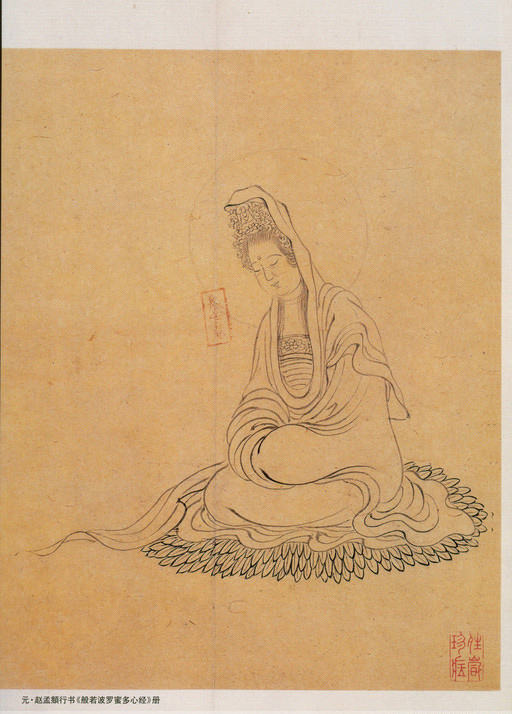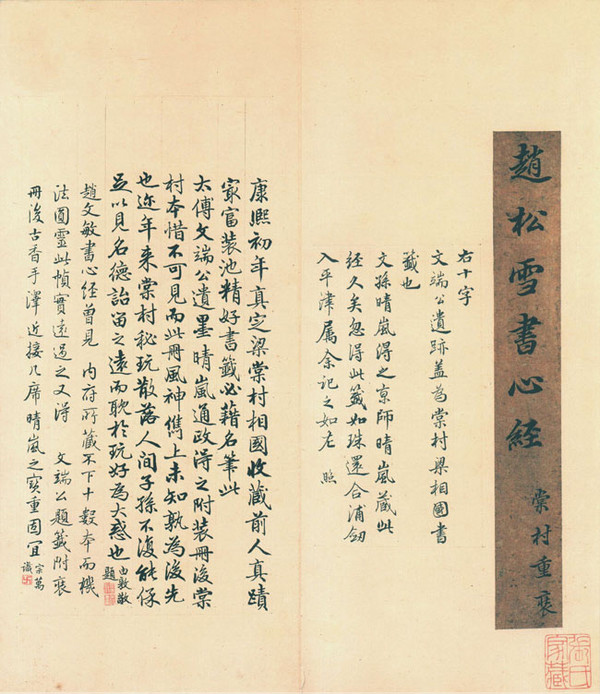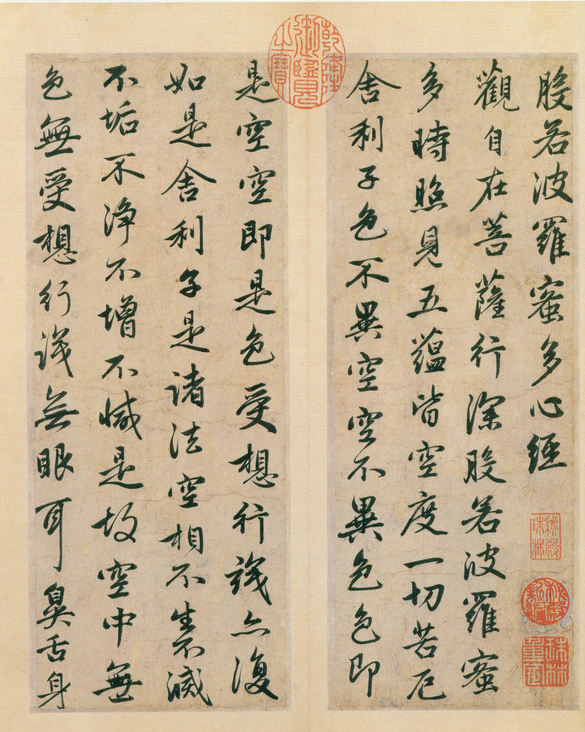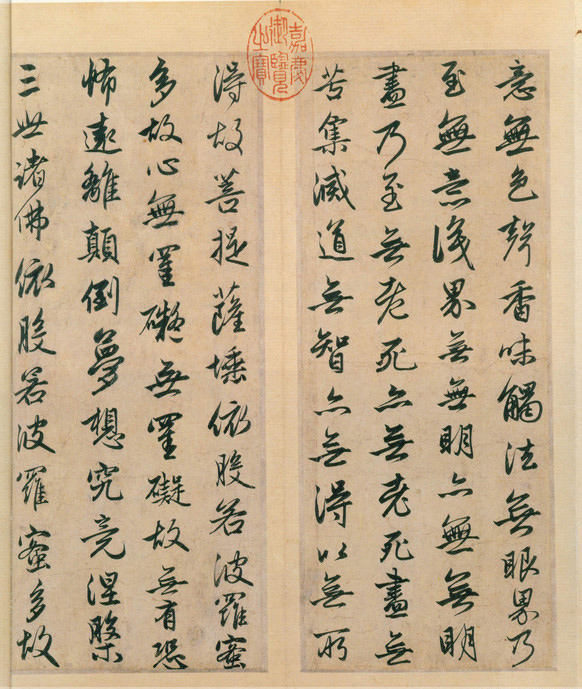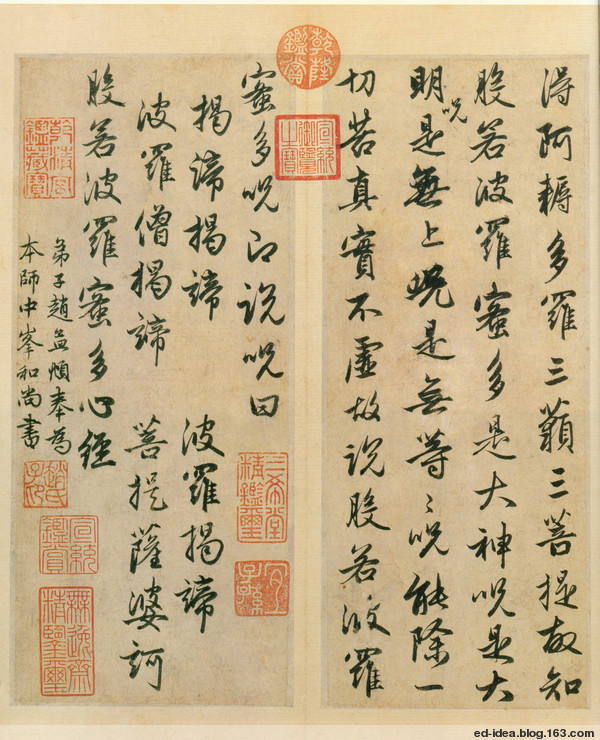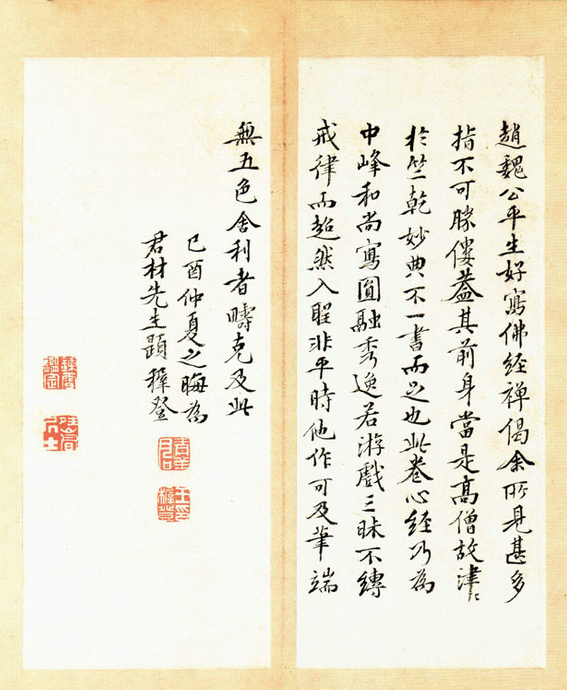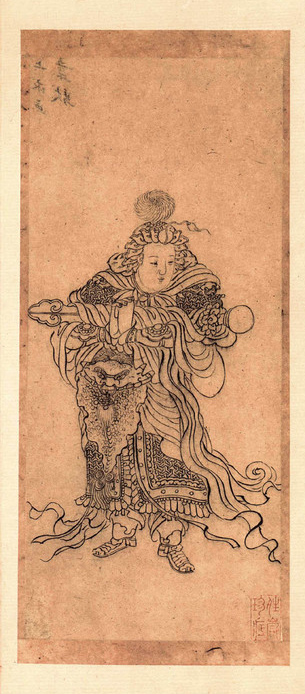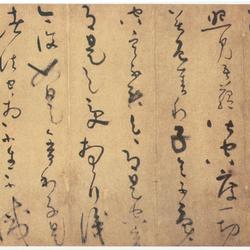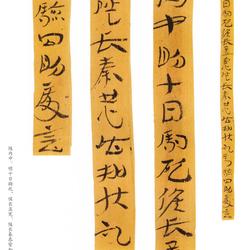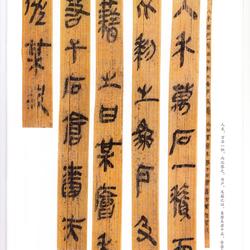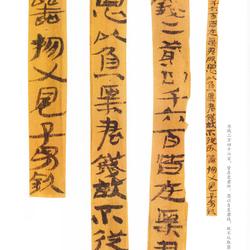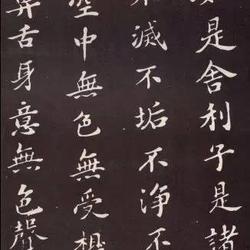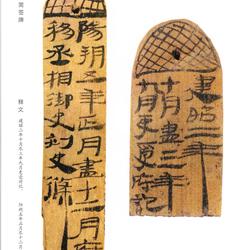"Heart Sutra" written by Zhao Mengfu of Yuan Dynasty
Zhao Mengfu (1254-1322), courtesy name Zi'ang, also known as Songxue, was a Songxue Taoist and a native of Huzhou (now Wuxing, Zhejiang). The eleventh grandson of Zhao Kuangyin, Taizu of the Song Dynasty, and the successor of King Defang of Qin. Zhao Mengfu experienced the changes of the Song and Yuan Dynasties throughout his life, and he was both an official and a recluse. Although he was a nobleman, he was born at the wrong time. In his youth, the Southern Song Dynasty was about to collapse, and he spent his time in ups and downs. His father, Zhao Yu, was a minister of the Ministry of Household Affairs and an envoy to the west of Zhejiang Province in Lin'an Prefecture. He was good at poetry and prose and had a rich collection, which gave Zhao Mengfu a good cultural influence. However, Zhao Mengfu's father passed away when he was eleven years old, and his family's circumstances were deteriorating, making life difficult. After the fall of the Song Dynasty, he returned to his hometown and lived idle.
Zhao Mengfu was a great calligrapher and painter of his generation. He experienced a life of complicated contradictions and embarrassing glory. As a relic of the Southern Song Dynasty, he became an official in the Yuan Dynasty. This has left many controversies in history books. "Thinking about his people will belittle his writing", belittling Zhao Mengfu's calligraphy style, the fundamental reason is that he despises Zhao Mengfu's person. Although many people criticize Zhao Mengfu's painting skills because of his official career, it is unfair to use non-artistic factors as a way to judge the artist's artistic level. In view of Zhao Mengfu's achievements in the history of art and culture, in 1987, the International Astronomical Society named the Mercury crater after Zhao Mengfu to commemorate his contribution to the history of human culture. Zhao Mengfu's calligraphy, painting and ink writings scattered in Japan, the United States and other places are regarded as treasures and properly preserved.
Zhao Mengfu was erudite and talented. He was good at poetry and prose, understood economics, was good at calligraphy and painting, was good at epigraphy and stone, knew the rules and regulations, and understood appreciation. In particular, he achieved the highest achievements in calligraphy and painting, creating a new style of painting in the Yuan Dynasty, and was known as the "Crown of the Yuan Dynasty". In painting, landscapes, figures, flowers and birds, bamboos and rocks, and pommel horses are omnipotent; fine brushwork, freehand brushwork, green, and ink are also masterful. He already occupies an important position in the history of Chinese calligraphy. Zhao Mengfu began to study calligraphy since he was five years old. He continued to read and write calligraphy until his death. He was good at seal script, official script, Zhen script, Xing script and cursive script, and was especially famous for his regular script and running script. According to the "History of the Yuan Dynasty", "Meng Fu's seal script, official script, Zhen script and cursive script are all the best in ancient and modern times, so he is famous all over the world for his books." Yushu of the Yuan Dynasty said in "Kong Xue Zhai Ji": "Zi'ang's seal script, Li, Zhen, Xing and Biancao are the best in the contemporary era, and his small regular script is the first among all Zi'ang's calligraphy." His calligraphy style is charming, elegant and well-structured. Strict and neat, with sophisticated brushwork, it is known as "Zhao style" in the world. Together with Yan Zhenqing, Liu Gongquan and Ouyang Xun, they are called the "Four Masters" of regular script.
Zhao Mengfu has many handwritten writings handed down from generation to generation, and his representative works include "Qian Zi Wen", "Luo Shen Fu", "Deng Ba Stele", "Come Back and Come Back", "Lanting Thirteen Postscripts", "Red Cliff Fu", and "Tao Te Ching" , "Qiu E's Tombstone Inscription" and so on. He is the author of 12 volumes of "Notes on Shangshu" and "Collected Works of Song Xuezhai".
From the "Prajnaparamita Heart Sutra" introduced here, we can see his important position in the history of Chinese calligraphy as a link between the past and the future.
"Heart Sutra" album set, 3 pages. Opening 1 before opening 1 is a white drawing of the statue of Guanyin. The first page after the third page is a white-painted image of Veda, and the second and third pages behind it are postscripts by Wang Zhideng of the Ming Dynasty, Zhang Ying, Zhang Zhao, Li Zongwan and others of the Qing Dynasty, and the original title signatures of the Liang Qing Dynasty. Each order is 288 cm long and 108 cm wide. This volume was originally collected by Zhang Ruo'ai in the Qing Dynasty and has seals such as "Lianxue Appraisal" and "Qinglan Jushi". Entering the Qing Palace during the Qianlong period, there are seals stored in the imperial palaces of Qianlong, Jiaqing and Xuantong. The "Heart Sutra" was originally a hand scroll. After entering the Qing Dynasty, it was changed into an album and added with carved sandalwood plywood. The "Avalokitesvara" and "Vedo" before and after the "Heart Sutra" were painted by people from the Qing Dynasty. It is recorded in "Secret Edition of the Pearl Forest in the Secret Palace".
This volume of "Prajna Paramita Heart Sutra" is a representative work of Zhao Mengfu. It can be written freely, cleanly and smoothly, and has its own appearance. However, upon closer analysis, it feels like every word has its own origin. We know that the art of calligraphy and painting in the Song Dynasty had declined by the end of the Southern Song Dynasty. The painting style of Ma Yuan and Xia Gui was mostly empty and rough, with no charm at all. Calligraphy has long lost the vivid charm of the Northern Song Dynasty. The handed down "Self-written Poems" by Zhao Mengjian and "Preface to the Collection of Wooden Chicken" by Wen Tianxiang illustrate this situation. Zhao Mengfu, who lived in this era, tried to correct the current shortcomings and make a difference. Just like the old-fashioned reform that was common in Chinese history, he also advocated "valuing ancient ideas" in calligraphy and painting to revive the decline. In terms of calligraphy, he carefully copied the copybooks of Zhong Yao, Wang Xizhi, Wang Xianzhi and Zhiyong, striving to absorb nutrients from the works of people in the Wei and Jin Dynasties. But at the end of the Song Dynasty and the beginning of the Yuan Dynasty, there was no longer the charm of the Eastern Jin Dynasty with Xuanfeng as the background. The rubbings copied by Zhao Mengfu are far different from the original manuscripts by Zhong, Wang and Zhiyong. In this way, Zhao's calligraphy can only be the shadow of the ancients, but cannot be the reproduction of the ancients. In addition, Jin people sat on the ground and wrote in the air, which was completely different from the Yuan Dynasty's posture of sitting on high chairs and writing according to the case, and the writing effect was completely different. In this way, although Zhao Mengfu subjectively followed the ancients, he actually developed a new style of calligraphy that looked like the ancients. Zhao Mengfu's wholehearted respect for the ancients and his method of copywriting had a great influence on calligraphy since the Ming and Qing Dynasties. As for his use of running script and the structure of small regular script to write large regular script, he created a flexible Zhao style regular script that is different from the rigid regular script of Ou, Liu and Yan styles. Because of its strong adaptability, it can be used to write large plaques and transcribe palace examinations. The larger the volume, the greater the impact. If you look at the Yuan Dynasty, all engravings were in the Zhao style, and you can see how popular the Zhao style was.
The "Prajnaparamita Heart Sutra" written by Zhao Mengfu is not the only one. This volume is written for monk Zhongfeng. Zhongfeng Shi Mingben, named Zhongfeng, an eminent monk in the Yuan Dynasty, presided over the Huanzhu Temple in Bianshan, Wuxing. Yuan Renzong once conferred the title of Zen Master Foci Yuanzhao. After his death, he was given the posthumous title Puying Guoshi. Zhongfeng's younger brother, Zhao Mengfu, was nine years old, but Zhao was very respectful to Zhongfeng. Since the Northern Dynasties, Buddhist believers have often written sutras themselves or hired people to write sutras as merit. But the scriptures are written. Both used regular script, and Zhao Mengfu wrote the Heart Sutra in running script. It is an unprecedented example in the history of scripture writing.
Wang Zhideng's postscript of this volume says: "Zhao Weiping was good at writing Buddhist scriptures and Zen verses, but he has seen so many things that I can't even point him out. Because his predecessor must have been an eminent monk, he devoted himself to Zhuqian's wonderful scriptures, not even a single book is enough." Yes." In fact, in the special dynasty of the Yuan Dynasty, intellectuals, whether they were in the opposition or in official positions, were somewhat depressed. Some of them escaped from Zen to Taoism, or they fell in love with mountains and rivers, or even lingered in Fengyue, writing dramas as calligraphers. It is impossible for these people to have all been eminent monks before. As for Zhao Mengfu, on the one hand, he was despised by the survivors because he served in the Yuan Dynasty as a member of the Zhao and Song clan; on the other hand, he was ostracized by the Mongolian ministers in the Yuan Dynasty court, so that he had to confess to the emperor: "The past is no longer something to talk about, and it will be Loyalty and direct repayment to the emperor." In this state of mind, he wrote a poem "Sin Out", saying:
In the mountains it is Polygala, and out of the mountains it is grass.
As the old saying goes, it's never too early to see the bitterness of things.
Who caused me to fall into the net of dust and be entangled gracefully?
In the past, I was a gull on the sea, now I am a bird in a cage.
A "caged bird" looking for sustenance from Buddhism may have nothing to do with whether his predecessor was a eminent monk or not. What's more, Zhao Mengfu also wrote Taoist classics such as "Dongxuan Natural Nine Heavens Ascension Chapter Sutra", which has nothing to do with eminent monks. Wang Zhideng was one of the so-called "mountain men" in the late Ming Dynasty. Shen Defu, a man at that time, wrote in "Wanli Yehuobian·Shanren". Satirize Wang Zeng. The crudeness of Wang's postscript in this volume proves that Shen's sarcasm is quite justified.
